This document discusses art in Northern Europe and the Iberian Peninsula during the 16th century. It covers major artistic developments in Germany, including the effects of the Protestant Reformation on art. Key artists mentioned are Albrecht Dürer, Matthias Grünewald, and Lucas Cranach the Elder. It also summarizes some of their major works, including Dürer's self-portrait and engravings, Grünewald's Isenheim Altarpiece, and Cranach's Nymph of the Spring. Sculptors like Tilman Riemenschneider are also briefly discussed.
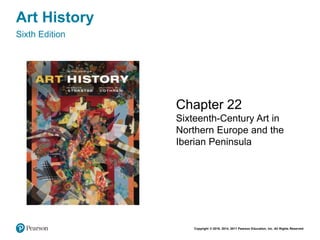


![Albrecht Dürer SELF-PORTRAIT
1500. Signed "Albrecht Dürer of Nuremberg…age 28."
Oil on wood panel, 26-1/4" × 19-1/4" (66.3 × 49 cm).
Alte Pinakothek, Munich. © 2016. Photo Scala, Florence/bpk, Bildagentur für Kunst,
Kultur und Geschichte, Berlin. [Fig. 22-01]](https://image.slidesharecdn.com/0134484592ch22-190210221605/85/0134484592-ch22-4-320.jpg)

![WESTERN EUROPE DURING THE REFORMATION, C. 1560
Sixteenth-century Europe remained largely Roman Catholic, except in Switzerland and
the far north, where the impact of the Protestant Reformation was strongest.
[Map 22-01]](https://image.slidesharecdn.com/0134484592ch22-190210221605/85/0134484592-ch22-6-320.jpg)

![APPLE CUP
c. 1510–1515. Gilt silver, height 8-1/2" (21.5 cm).
Germanisches Nationalmuseum, Nuremberg. © 2016. Photo Scala, Florence. [Fig. 22-02]](https://image.slidesharecdn.com/0134484592ch22-190210221605/85/0134484592-ch22-8-320.jpg)
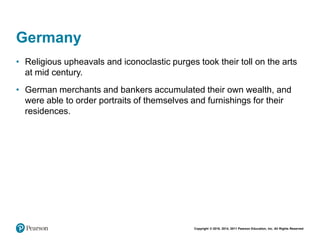
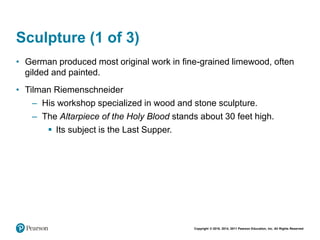
![Tilman Riemenschneider ALTARPIECE OF THE HOLY BLOOD (OPEN)
Sankt Jakobskirche (church of St. James), Rothenburg ob der Tauber, Germany. Center,
Last Supper. c. 1499–1505. Limewood, glass, height of tallest figure 39" (99.1 cm),
height of altar 29'6" (9 m). © akg-images/Erich Lessing. [Fig. 22-03]](https://image.slidesharecdn.com/0134484592ch22-190210221605/85/0134484592-ch22-11-320.jpg)


![Nikolaus Hagenauer (central panels and predella) and Matthias Grünewald (wings)
ISENHEIM ALTARPIECE (OPEN)
From the Community of St. Anthony, Isenheim, Alsace, France. Center panels and
predella: St. Anthony Enthroned between SS. Augustine and Jerome, Christ and the
Apostles, c. 1500. Painted and gilt limewood, center panel 9'9-1/2" × 10'9"
(2.97 × 3.28 m), predella 2'5-1/2" × 11'2" (0.75 × 3.4 m). Wings: SS. Anthony and Paul
the Hermit (left); The Temptation of St. Anthony (right). 1510–1515. Oil on wood panel,
8'2-1/2" × 3'-1/2" (2.49 × 0.93 m).Musée d'Unterlinden, Colmar, France. Bridgeman
Images. [Fig. 22-04]](https://image.slidesharecdn.com/0134484592ch22-190210221605/85/0134484592-ch22-14-320.jpg)

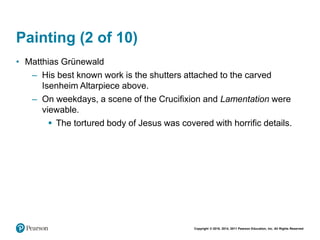
![Matthias Grünewald ISENHEIM ALTARPIECE (CLOSED)
From the Community of St. Anthony, Isenheim, Alsace, France. Center panels:
Crucifixion; predella: Lamentation; side panels: SS. Sebastian (left) and Anthony Abbot
(right). c. 1510–1515. Date 1515 on ointment jar. Oil on wood panel, center panels 9'9-
1/2" × 10'9" (2.97 × 3.28 m) overall, each wing 8'2-1/2" × 3'-1/2" (2.49 × 0.93 m), predella
2'5-1/2" × 11'2" (0.75 × 3.4 m). Musée d'Unterlinden, Colmar, France. Bridgeman Images.
[Fig. 22-05]](https://image.slidesharecdn.com/0134484592ch22-190210221605/85/0134484592-ch22-17-320.jpg)

![Matthias Grünewald ISENHEIM ALTARPIECE (FIRST OPENING)
Left to right: Annunciation, Virgin and Child with Angels, Resurrection. c. 1510–1515.
Oil on wood panel, center panel 9'9-1/2" × 10'9" (2.97 × 3.28 m) overall, each wing 8’10"
× 4' 8" (2.69 × 1.42 m). Musée d'Unterlinden, Colmar, France. Bridgeman Images
[Fig. 22-06]](https://image.slidesharecdn.com/0134484592ch22-190210221605/85/0134484592-ch22-19-320.jpg)

![Albrecht Dürer THE FOUR HORSEMEN OF THE APOCALYPSE
From The Apocalypse. 1497–1498. 1511 edition. Woodcut, 15-1/2" × 11-1/16" (39.4 ×
28.1 cm). ). Yale University Art Gallery, New Haven, Connecticut. Library transfer, Gift of
Paul Mellon, B.A. 1929 (1956.16.3e). Image courtesy Yale University Art Gallery.
[Fig. 22-07]](https://image.slidesharecdn.com/0134484592ch22-190210221605/85/0134484592-ch22-21-320.jpg)

![Albrecht Dürer ADAM AND EVE
1504. Engraving, 9-5/8" × 7-5/8" (244 × 19.3 cm).
Yale University Art Gallery, New Haven, Connecticut. Fritz Achelis Memorial Collection,
Gift of Frederic George Achelis, B.A. 1907; reacquired in 1972 with the Henry J. Heinz II,
B.A. 1931, Fund; Everett V. Meeks, B.A. 1901, Fund; and Stephen Carlton Clark, B.A.
1903, Fund (1925.29). Image courtesy Yale University Art Gallery. [Fig. 22-08]](https://image.slidesharecdn.com/0134484592ch22-190210221605/85/0134484592-ch22-23-320.jpg)

![Albrecht Dürer FOUR APOSTLES
1526. Oil on wood panel, each panel 7'-1/2" × 2'6" (2.15 × 0.76 m).
Alte Pinakothek, Munich. Photo © Bayer@Mitko/ARTOTHEK. [Fig. 22-09]](https://image.slidesharecdn.com/0134484592ch22-190210221605/85/0134484592-ch22-25-320.jpg)


![Lucas Cranach the Elder NYMPH OF THE SPRING
c. 1537. Oil on panel, 19" × 28-1/2" (48.5 × 72.9 cm).
National Gallery of Art, Washington, DC. Image courtesy the National Gallery of Art,
Washington. [Fig. 22-10]](https://image.slidesharecdn.com/0134484592ch22-190210221605/85/0134484592-ch22-28-320.jpg)

![Hans Baldung Grien DEATH AND THE MATRON
c. 1520–1525. Oil on wood panel, 12-3/8" × 7-3/8" (31.3 × 18.7 cm).
Öffentliche Kunstsammlung, Basel. Photo © Hans Hinz/ARTOTHEK. [Fig. 22-11]](https://image.slidesharecdn.com/0134484592ch22-190210221605/85/0134484592-ch22-30-320.jpg)

![Albrecht Altdorfer DANUBE LANDSCAPE
c. 1525. Oil on vellum on wood panel, 12" × 8-1/2" (30.5 × 22.2 cm).
Alte Pinakothek, Munich. © 2016. Photo Scala, Florence/bpk, Bildagentur für Kunst,
Kultur und Geschichte, Berlin. [Fig. 22-12]](https://image.slidesharecdn.com/0134484592ch22-190210221605/85/0134484592-ch22-32-320.jpg)




![Jean Clouet FRANCIS I
1525–1530. Oil and tempera on wood panel, 37-3/4" × 29-1/8" (95.9 × 74 cm).
Musée du Louvre, Paris. © 2016. Photo Scala, Florence. [Fig. 22-13]](https://image.slidesharecdn.com/0134484592ch22-190210221605/85/0134484592-ch22-37-320.jpg)
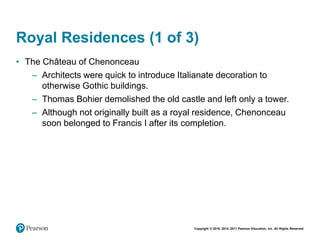
![CHÂTEAU OF CHENONCEAU
Touraine, France. Original building (at right) 1513–1521; gallery on bridge at left by
Philibert de l'Orme, finished c. 1581. Wildman/Fotolia. [Fig. 22-14]](https://image.slidesharecdn.com/0134484592ch22-190210221605/85/0134484592-ch22-39-320.jpg)

![Primaticcio STUCCO AND WALL PAINTING, CHAMBER OF THE DUCHESS OF
ÉTAMPES, CHÂTEAU OF FONTAINEBLEAU
France. 1540s. Photo © RMN-Grand Palais (Château de Fontainebleau)/Jean-Pierre
Lagiewski. [Fig. 22-15]](https://image.slidesharecdn.com/0134484592ch22-190210221605/85/0134484592-ch22-41-320.jpg)

![Pierre Lescot and Jean Goujon WEST WING OF THE COUR CARRÉE, PALAIS DU
LOUVRE, PARIS
Begun 1546.
© akg-images/Erich Lessing. [Fig. 22-16]](https://image.slidesharecdn.com/0134484592ch22-190210221605/85/0134484592-ch22-43-320.jpg)


![Juan Bautista de Toledo and Juan de Herrera THE ESCORIAL
Madrid. 1563–1584. Detail from an anonymous 17th-century painting. Oil on canvas,
30-1/4 × 35-7/8” (77 × 91 cm). Monasterio-Pintura, San Lorenzo Del Escorial, Madrid.
© akg-images/Album/Oronoz [Fig. 22-17]](https://image.slidesharecdn.com/0134484592ch22-190210221605/85/0134484592-ch22-46-320.jpg)

![Diogo de Arruda WEST WINDOW, CHURCH IN THE CONVENT OF CHRIST, TOMAR
Portugal. c. 1510.
Commissioned by King Manuel I of Portugal. Lemtal/Fotolia. [Fig. 22-18]](https://image.slidesharecdn.com/0134484592ch22-190210221605/85/0134484592-ch22-48-320.jpg)

![El Greco BURIAL OF COUNT ORGAZ
Church of Santo Tomé, Toledo, Spain. 1586.
Oil on canvas, 16' × 11'10" (4.88 × 3.61 m).
Courtesy of Marilyn Stokstad. [Fig. 22-19]](https://image.slidesharecdn.com/0134484592ch22-190210221605/85/0134484592-ch22-50-320.jpg)


![Hieronymus Bosch GARDEN OF EARTHLY DELIGHTS (OPEN)
c. 1505–1515. Oil on wood panel, center panel 7'2-1/2" × 6'4-3/4" (2.20 × 1.95 m),
each wing 7'2-1/2" × 3'2" (2.20 × 0.97 m).
Museo del Prado, Madrid. © 2016. Image copyright Museo Nacional del Prado. © Photo
MNP/Scala, Florence. [Fig. 22-20]](https://image.slidesharecdn.com/0134484592ch22-190210221605/85/0134484592-ch22-53-320.jpg)

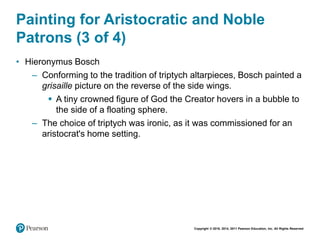
![Hieronymus Bosch GARDEN OF EARTHLY DELIGHTS (CLOSED)
© 2016. Photo Scala, Florence. [Fig. 22-21]](https://image.slidesharecdn.com/0134484592ch22-190210221605/85/0134484592-ch22-56-320.jpg)

![Jan Gossaert ST. LUKE DRAWING THE VIRGIN MARY
1520. Oil on panel, 43-3/8" × 32-1/4" (110.2 × 81.9 cm).
Kunsthistorisches Museum, Vienna. © akg-images/Erich Lessing. [Fig. 22-22]](https://image.slidesharecdn.com/0134484592ch22-190210221605/85/0134484592-ch22-58-320.jpg)


![Quentin Massys MONEY CHANGER AND HIS WIFE
1514. Oil on panel, 28" × 26-3/4" (71.2 × 68 cm).
Kunsthistorisches Museum, Vienna. Photo © RMN-Grand Palais (Musée du Louvre)/Tony
Querrec. [Fig. 22-23]](https://image.slidesharecdn.com/0134484592ch22-190210221605/85/0134484592-ch22-61-320.jpg)

![Caterina van Hemessen SELF-PORTRAIT
1548. Oil on wood panel, 12-1/4" × 9-1/4" (31.1 × 23.5 cm).
Öffentliche Kunstsammlung, Basel. Photo: Martin Buhler/Kunstmuseum Basel.
[Fig. 22-24]](https://image.slidesharecdn.com/0134484592ch22-190210221605/85/0134484592-ch22-63-320.jpg)
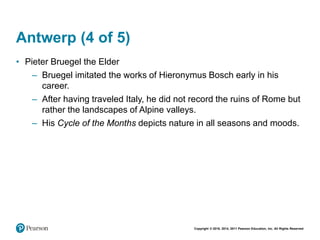

![Pieter Bruegel the Elder RETURN OF THE HUNTERS
1565. Oil on wood panel, 3'10-1/2" × 5'3-3/4" (1.18 × 1.61 m).
Kunsthistorisches Museum, Vienna. © akg-images/Erich Lessing. [Fig. 22-25]](https://image.slidesharecdn.com/0134484592ch22-190210221605/85/0134484592-ch22-66-320.jpg)
![Pieter Bruegel the Elder THE HARVESTERS
1565. Oil on wood panel, 46-7/8" × 63-3/4" (1.17 × 1.6 m).
Metropolitan Museum of Art, New York. Rogers Fund, 1919. (19.164). © 2016. Image
copyright The Metropolitan Museum of Art, New York/Art Resource, NY/Scala, Florence.
[Fig. 22-26]](https://image.slidesharecdn.com/0134484592ch22-190210221605/85/0134484592-ch22-67-320.jpg)


![A CLOSER LOOK: The French Ambassadors by Hans Holbein the Younger
1533. Oil on wood panel. 81-1/8" × 82-5/8" (2.07 × 2.1 m).
National Gallery, London. © 2016. Copyright The National Gallery, London/Scala,
Florence. [Fig. 22-27]](https://image.slidesharecdn.com/0134484592ch22-190210221605/85/0134484592-ch22-70-320.jpg)

![Marcus Gheeraerts the Younger QUEEN ELIZABETH I (THE DITCHLEY PORTRAIT)
c. 1592. Oil on canvas, 95" × 60" (2.4 × 1.5 m).
National Portrait Gallery, London. Photo © Stefano Baldini/Bridgeman Images.
[Fig. 22-28]](https://image.slidesharecdn.com/0134484592ch22-190210221605/85/0134484592-ch22-72-320.jpg)

![Nicholas Hilliard GEORGE CLIFFORD, THIRD EARL OF CUMBERLAND
c. 1595. Watercolor on vellum on card, oval 2-3/4" × 2-3/16" (7.1 × 5.8 cm).
The Nelson-Atkins Museum of Art, Kansas City, Missouri. Gift of Mr. and Mrs. John W.
Starr through the Starr Foundation. F58-60/188 [Fig. 22-29]](https://image.slidesharecdn.com/0134484592ch22-190210221605/85/0134484592-ch22-74-320.jpg)

![Robert Smythson HARDWICK HALL
Derbyshire, England. 1591–1597.
© Phil MacD Photography/Shutterstock. [Fig. 22-30]](https://image.slidesharecdn.com/0134484592ch22-190210221605/85/0134484592-ch22-76-320.jpg)

![Jacob Halder ARMOR OF GEORGE CLIFFORD, THIRD EARL OF CUMBERLAND
Made in the royal workshop at Greenwich, England. c. 1580–1583.
Steel and gold, height 5'9-1/2" (1.77 m). Metropolitan Museum of Art, New York. Munsey
Fund, 1932 (32.130.6). © 2016. Image copyright The Metropolitan Museum of Art/Art
Resource/Scala, Florence. [Fig. 22-31]](https://image.slidesharecdn.com/0134484592ch22-190210221605/85/0134484592-ch22-78-320.jpg)

![Robert Smythson HIGH GREAT CHAMBER, HARDWICK HALL
Derbyshire, England. 1591–1597.
Brussels tapestries 1550s; painted plaster sculpture by Abraham Smith.
National Trust Photographic Library/Andreas von Einsiedel/Bridgeman Images.
[Fig. 22-32]](https://image.slidesharecdn.com/0134484592ch22-190210221605/85/0134484592-ch22-80-320.jpg)

